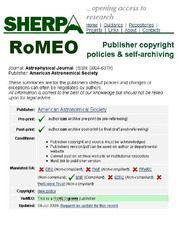| dc.contributor.author | Montez, Rodolfo | |
| dc.contributor.author | Kastner, Joel | |
| dc.contributor.author | Sahai, R. | |
| dc.date.accessioned | 2009-02-23T15:50:02Z | |
| dc.date.available | 2009-02-23T15:50:02Z | |
| dc.date.issued | 2006 | |
| dc.identifier.citation | 2007 AAS/AAPT Joint Meeting, American Astronomical Society Meeting 209, #92.06; Bulletin of the American Astronomical Society, Vol. 38, p.1029 | en_US |
| dc.identifier.uri | http://hdl.handle.net/1850/8455 | |
| dc.description | RIT community members may access full-text via RIT Libraries licensed databases: http://library.rit.edu/databases/ | |
| dc.description.abstract | We report the detection by Chandra's Advanced CCD Imaging Spectrometer (ACIS) of X-ray emission from Hen 2-104, a D-type symbiotic Mira system that sits at the core of an hourglass-shaped bipolar nebula (the "Southern Crab"). The X-ray source is marginally resolved and is displaced 2 arcsec SE of the central symbiotic system, very near the position of an isolated, high-velocity feature detected in visual-wavelength echelle spectroscopy of Hen 2-104. Spectral modeling indicates a temperature in the range 3-9 MK for the X-ray-emitting plasma. These results indicate that the X-ray source arises in shocks along a polar jet (or system of bullets) with a large velocity gradient. Along with R Aqr, Menzel 3, and CH Cyg, Hen 2-104 is the fourth symbiotic Mira system observed by Chandra to show X-ray emission from strong shocks associated with (bi)polar jet or bullet systems. | en_US |
| dc.language.iso | en_US | en_US |
| dc.publisher | American Astronomical Society | en_US |
| dc.relation.ispartofseries | vol. 38 | en_US |
| dc.relation.ispartofseries | p. 1029 | en_US |
| dc.title | Chandra x-ray detection of a shocked polar jet in the symbiotic Mira System Hen 2-104 | en_US |
| dc.type | Abstract | en_US |

